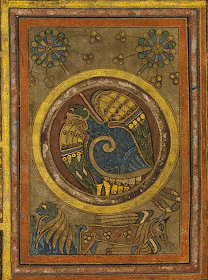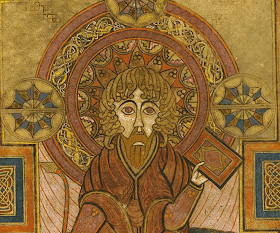- Mistakes
The text of
the Book of Kells is full of errors (Simpson, 2010). The majority of these
errors are minor spelling mistakes on the part of the scribes; a good number of
which were never corrected. However, the most glaring error in the book is the
duplication of a full page of text.
- Rubrication
The Book of Kells does not include any instances of rubication. In
place of the traditional red letter headings, illumination and paintings were
used to denote the beginning of sections.
- Decoration, Illuminations and Paintings
Due to the wide variety of artistic embellishments present in the
manuscript it is necessary, for the purpose of clarity, to define the three
subject headings of this section. To that end, for the purpose of this blog decoration will be defined as any
non-textual ink based adornment or small pigment based doodle; illuminations will be pigment based
embellishments or figural drawings incorporated into the text pages of the
manuscript; and full page art piece
will be defined and described under the heading of paintings.
While the Book of Kells’ age makes it a rare treasure, it is the
decorations, illustrations and paintings that have earned the manuscript its
justly deserved fame. Any discussion of the art of the manuscript must by its
nature be a brief survey as one can find multiple monographs dedicated to the
beauty of the artwork to be found within. This review will seek to point out
the highlights and illustrate what makes the manuscript so special.
All but two of the surviving pages, 29v and 301v contain
decorations or illuminations and there is evidence that these pages were
intended to be embellished before the manuscript was left unfinished. It was
not only illuminations that were left incomplete. There is strong evidence that
at least one page (123v), was intended to house a painting, which was never
begun; this will be covered in more detail below. It is also believed, based on
the structure of the surviving pages, that other folios containing paintings
have been lost.
Brown (1980, p. 90) states it well when he says that “More than
any other Insular manuscript, the Book of Kells has a profusion of
illustrations and ornaments, the elements of which are found in other
manuscripts but nowhere in such variety.”
Decorations:
 |
| Decorations made using dots of red lead. Folio 124r |
Decorations in the manuscript are most commonly seen in either the
brownish iron Gaul ink used for the majority of the text or pure red lead.
Common motifs include small clusters of grapes (200r) and geometric designs
completed through the use of dots or lines. The latter is incorporated into a
painting to great effect in folio 124r,
 |
| Lion. Folio 206r |
Illuminations:
 |
| Cat. Folio 183v |
As anyone who has seen even a simple page from the Book of Kells
would tell you, the illuminations are fantastic. Depictions of at least of 18
different animals have been notated (Simpson, 2010); the most common of which
is the cat, but others include the otter, eagle and snake. It is noted that the
inclusion of many of the symbols are intended to be a reference to Jesus. It is
believed that repeated inclusion of the peacock, fish, lion, and snake were
intended to reinforce the message that the book was the word of God. It is also
noted that the animals with which the monastic illustrators and scribes were
less familiar were drawn in a less realistic manor. This can be clearly seen by
comparing the illustration of a cat with that of a lion or a snake.
 Along with animals, another common illumination is the initial
capital at the beginning of a verse. There are over 2000 illuminated initial
capital letters (Simpson, 2010). These letters often include, or are made entirely of,
either human and/or animal forms. Examples of both can be seen on folio 253v
where two men pulling each other’s beards are used to create the letter N,
while a two animals eating humans are used to create a letter A.
Along with animals, another common illumination is the initial
capital at the beginning of a verse. There are over 2000 illuminated initial
capital letters (Simpson, 2010). These letters often include, or are made entirely of,
either human and/or animal forms. Examples of both can be seen on folio 253v
where two men pulling each other’s beards are used to create the letter N,
while a two animals eating humans are used to create a letter A.
Paintings:
It is believed (Meehan, 1994) that if completed the plan for the
manuscript would have included a page of evangelist symbols and portrait page
and a decorated page at the beginning of each of the four gospel book. There
are 33 surviving pages that can be described as containing paintings. As stated
above the pages containing
paintings were often single folios, not bifolia, this may be the reason why, if
they were completed, they have not survived through to the present day.
 | |
| Onlookers. Folio 124r |
A common practice among the illuminators was to paint a group of
onlookers into the border of the painting to draw the eye of the reader to the
important section. This can be seen in the paining of the Virgin and Child (7v)
as well as folio 124r, a page of ornamental text describing the crucifixion of
Christ. It is the presence of these onlookers that lead scholars to the
conclusion that the blank page adjunct to it, (123v) was intended to contain an
image of the crucifixion (Simpson, 2010). Of all the full page paintings
contained in the book, my favorites are 291v and 129v.
The painting of St. John (291v), while not as complex as many
other pages, is remarkable to me for a number of reasons. The apostle is depicted
holding the tools of the scribe. He holds a book in his left hand, a quill pen
in his right and has a bull horn, commonly used a an ink well, at his feet.
From an artistic perspective, I am drawn to the artist’s use of the natural
color of the vellum to fill in the negative space in his halo. The portrait is
also noteworthy for its illustration of damage done in by Mullen in his 1821
cropping of the margins. The painting is meant to show a figure whose hands and
feet are still intact standing behind the image. However, through the process
of cropping, only the beard and lower section of the halo remain of the person's face.
The other image that I find to be fascinating is that of the four
evangelists (129v). Their symbols are Matthew as a man, Mark as a lion, Luke as
a calf, and John as an eagle. The page is broken into four sections using a
cross. Each evangelist has their own section in which their symbol is enclosed
in a circle of Orpiment yellow. Although it is busier than the portrait of St.
John, I again find the still restrained ornamentation and the use of negative
space in this painting to be pleasing.
 |
| St. Mark as the Lion. Folio 129v |
 |
| St. Matthew as the man. Folio 129v |
 |
| St. Luke as the Lamb/Calf. Folio 129v |
 |
| St. John as the Eagle. Folio 129v |

No comments:
Post a Comment